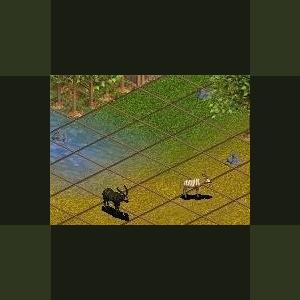About This File
The Nyala (Tragelaphus angasii) is a South African antelope.
General Characteristics
Body Length: 135-195 cm / 4.5-6.5 ft.
Shoulder Height: 80-120 cm / 2.6-4 ft
Tail Length: 40-55 cm / 16-22 in.
Weight: 55-140 kg / 121-308 lb.
There is extreme sexual dimorphism, with the two sexes looking entirely different. Both sexes have a white chevron between the eyes, and the bushy tail is white on the underside. The short-haired, rufous-chestnut coat of females and immature males has 10 or more vertical white stripes on the sides. There are white spots on the face, throat, flanks, and thighs. There are no horns on females, and there is no mane on the neck. The males are larger than females, and have a shaggy dark brown to charcoal grey coat, often with a bluish tinge. The length of this coat generally obscures the torso stripes. There are fewer and less conspicuous markings than on the female, but there is a bold erectile white dorsal crest. The lower legs are tawny. The yellow-tipped horns have 1-1.5 twists, and grow 60-83 cm / 24-33 inches long.
Ontogeny and Reproduction
Gestation Period: 7 months
Young per Birth: 1
Weaning: After 6 months
Sexual Maturity: Females at 11-12 months, males at 18 months [although they are not socially mature until 5 years of age].
Life span: Up to 16 years.
Breeding is most frequent in the spring and autumn, with births occurring in the following autumn and spring. Calves are left alone after birth, lying still in the grass to avoid detection by predators. The mother returns to her calf to nurse throughout this three week period.
Ecology and Behavior
Nyala are very shy, and are very cautious when approaching open spaces. Most sightings of wild nyala are at water holes. They are most active during the early morning and late afternoon, resting in thick brush during the hottest times of the day. The alarm call is a sharp, dog-like bark. Individual nyala home ranges average 0.65 square kilometers for males and 0.83 kilometers for females. These individual areas overlap extensively, and there is no indication of territoriality.
Family group: Single sex and mixed troops of 2-10 individuals, old bulls solitary.
Diet: Leaves, fruits, and grasses.
Main Predators: Leopard, lion, Cape hunting dog.
Distribution
Dense lowland woodlands and thickets near water in southern Malawi, Mozambique, Zimbabwe, and eastern South Africa.
Countries: Botswana [introduced], Malawi, Mozambique, Namibia [introduced], South Africa, Swaziland, Zimbabwe (IUCN, 2002).
Created by Jordan for Zoo Tek - 2007
Updated 2010-11-04
Just to save space with less in zip and smaller image.
Nothing new.



Recommended Comments
There are no comments to display.
Create an account or sign in to comment
You need to be a member in order to leave a comment
Create an account
Sign up for a new account in our community. It's easy!
Register a new accountSign in
Already have an account? Sign in here.
Sign In Now